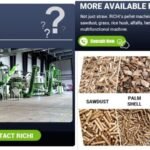Establishing a 5T/H Complete Feed Mill Plant in Haiti presents a compelling opportunity to support the country’s growing livestock and poultry sectors. However, the profitability of such a venture hinges on several critical factors, including market demand, raw material availability, economic conditions, and competition. Here’s a detailed analysis of the potential profitability and key considerations for this project:
Market Demand and Potential
Poultry Industry:
- The poultry sector in Haiti is expanding, driven by increasing demand for meat and eggs.
- A local feed mill could capture a significant portion of this market, reducing reliance on imported feed and offering consistent, quality products.
Livestock Sector:
- The cattle and pig farming industries are essential components of Haiti’s agricultural economy, requiring substantial feed inputs.
- The mill could serve this market by producing specialized feed for dairy and beef cattle, as well as pigs.
Import Substitution:
- Haiti’s reliance on imported feed, especially from neighboring countries, presents a substantial opportunity for local production.
- A feed mill could offer competitive pricing and logistical advantages, reducing the need for imports and supporting local agriculture.

Raw Material Availability
Local Sourcing:
- Haiti produces some of the necessary raw materials, such as corn and sorghum, but the availability can be inconsistent.
- Establishing strong relationships with local farmers could secure a stable supply, though this may require investment in agricultural development.
Import Dependency:
- Key ingredients like soybean meal and vitamins might need to be imported, leading to higher costs and exposure to currency fluctuations.
- Securing favorable import contracts and managing currency risk will be crucial.
Economic and Political Factors
Currency Devaluation:
- The Haitian gourde’s devaluation poses a significant risk, particularly for imported raw materials and equipment.
- Strategies to mitigate this risk, such as hedging and local currency financing, could be essential.
Political Instability:
- Frequent political unrest can disrupt operations, making it challenging to maintain consistent production.
- Building flexibility into the business plan and establishing contingency measures will be necessary.
Infrastructure Challenges:
- Poor road conditions and unreliable electricity are common in Haiti, potentially increasing operational costs.
- Investing in backup power solutions and efficient logistics will be vital to maintain profitability.
Competition and Market Entry
Existing Players:
- While Haiti Broilers’ exit from the market reduces direct competition, smaller feed producers and the informal sector remain significant players.
- Differentiating through quality, price, and value-added services will be essential to capture market share.
Import Competition:
- Competing against lower-cost imported feed, particularly from the Dominican Republic, requires a strong value proposition.
- Local production can offer fresher products with lower transportation costs, appealing to cost-conscious farmers.
Financial Considerations
Initial Investment:
- The estimated investment for a 5T/H feed mill is substantial, ranging from $3-5 million USD.
- This includes costs for equipment, construction, and initial working capital, with potential financing challenges in Haiti.
Operating Costs:
- While labor costs are relatively low, energy and maintenance expenses may be high due to infrastructure issues.
- Efficient operations and cost control measures will be critical to maintaining profitability.
Pricing Strategy:
- Pricing must be competitive with imports while ensuring a sustainable profit margin.
- The ability to offer value-added products and services could justify premium pricing.
Potential Profitability Scenarios
- Optimistic Scenario:
- High market penetration with successful import substitution.
- Strong raw material supply chains and minimal operational disruptions.
- Potential annual revenue: $10-15 million USD.
- Estimated profit margin: 15-20%.
- Moderate Scenario:
- Partial market penetration with some supply chain challenges.
- Occasional disruptions due to political and infrastructure issues.
- Potential annual revenue: $7-10 million USD.
- Estimated profit margin: 10-15%.
- Challenging Scenario:
- Intense competition from imports and the informal sector.
- Frequent disruptions and raw material sourcing difficulties.
- Potential annual revenue: $5-7 million USD.
- Estimated profit margin: 5-10%.
Strategies for Enhancing Profitability
- Vertical Integration: Consider integrating poultry or livestock production to secure a stable market for the feed.
- Diversification: Offer a variety of feed types to spread risk and capture different market segments.
- Technology Adoption: Invest in modern, efficient equipment to reduce costs and ensure consistent quality.
- Local Partnerships: Build strong relationships with local farmers for raw material supply and distribution.
- Government Engagement: Advocate for policies that support local feed production and protect against unfair competition.
Challenges to Profitability
- Political Instability: Frequent changes in government and civil unrest can create an unpredictable business environment.
- Currency Risk: Volatility in the Haitian gourde can impact the cost of imported inputs and financial stability.
- Infrastructure Limitations: Poor roads and unreliable electricity supply can increase costs and complicate distribution.
- Market Education: Educating farmers on the benefits of commercial feed may require significant investment.
- Quality Control: Maintaining consistent feed quality with variable raw materials could be challenging.
Conclusion
Building a 5T/H commercial feed mill in Haiti offers significant potential for profitability, particularly given the need for local feed production and the growth of the livestock and poultry sectors. However, the venture is not without risks, including political instability, economic volatility, and infrastructure challenges.
Success will depend on careful planning, robust risk management, and a commitment to building strong local partnerships. While the potential for profitability is there, investors should approach this opportunity with caution, conducting thorough due diligence and preparing for the complexities of operating in Haiti.


